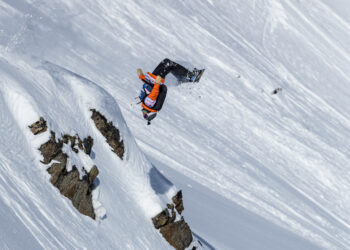
By Todd Wilkinson EBS Environmental Columnist
Last autumn, only a few months after he had been profiled by Anderson Cooper on CBS’s “60 Minutes,” photographer Tom Mangelsen was standing in a wall tent outside his home near Moose, Wyoming. He regaled guests—people from across the country who had collected his fine art images—with the tale of a picnic.
With stars in the cosmos hovering over the Tetons, as if sparkling on high beam, Mangelsen shared the details of how his close friendship with Dr. Jane Goodall—the renowned primatologist and globetrotting promoter of conservation—came to be. It started, he noted, with an outing to Yellowstone National Park in search of grizzly bears.
That night in September 2018, with Goodall sitting nearby listening to Mangelsen recount details of their foray in America’s first national park, she quibbled, much to the delight of those in the tent, with Mangelsen’s storytelling.
However, the gist of their mutual recollection was the same: grizzlies possess the same kind of sentience, intelligence, emotions, charisma and personalities as the chimpanzees Goodall studied in Tanzania’s Gombe National Park, she said.
The whole idea that a population of bears would be brought back from the brink of extirpation, only to have some targeted for sport hunting—“killing for fun and having their hides turned into floor rugs”— Goodall noted, was not only repulsive to consider but also beneath the dignity of their human stewards.
As most people in the Greater Yellowstone Ecosystem know, Mangelsen has been an outspoken advocate of grizzlies, especially that of Jackson Hole grizzly 399 and her family, which Mangelsen and I made the subject of our 2015 book, “Grizzlies of Pilgrim Creek.”
Mangelsen praises the campaign started by five women from Jackson Hole called “Shoot’Em With A Camera (Not a Bullet)” that last year attracted worldwide public attention.
The campaign was punctuated by the fact that both Mangelsen and Goodall submitted their names into the lottery to win one of 21 Wyoming grizzly hunting tags. Goodall’s name wasn’t drawn, but Mangelsen’s was, and he noted that he would go hunting bears with his lens, not a rifle.
In September 2018, a U.S. District Court judge ordered that Greater Yellowstone grizzlies be placed back on the federal protected list, effectively halting the first sport hunt of the bruins in 44 years.
Across more than four decades, Mangelsen has become one of the most recognized names in the world for wildlife photography. The Nebraska native, who grew up as a trapper, waterfowl hunter and, notably, a world-champion goose caller, has undergone a profound metamorphosis with his conservation values. For most of his adult life, he’s used beautiful wildlife and landscape shots to call public attention to the rapid ongoing loss of species and the wild places they inhabit.
Right now, the retrospective exhibition, “Thomas D. Mangelsen: A Life in the Wild,” is on display at the National Museum of Wildlife Art in Jackson Hole through May 5, as a part of a 15-venue national tour that will also reach Bozeman’s Museum of the Rockies in autumn 2021 and the Buffalo Bill Center of the West in Cody in the summer of 2022.
From the redwood forests to the High Arctic, where he took award-winning photographs of polar bears—touted as historically important visions drawing attention to climate change—to African megafauna, tigers in India, the sandhill crane migration along the Platte River and, of course, to numerous nature portraits made in Greater Yellowstone, Mangelsen’s series of “Legacy Images,” displayed large, are serious wake-up calls that do not dampen our spirit but inspire.
Joel Sartore, the vaunted nature photographer who was also profiled not long ago on “60 Minutes,” is on his own mission to document the large toll of species living on the very edge of extinction. An exhibition of Sartore’s work also appeared at the National Museum of Wildlife Art.
Sartore told me that Mangelsen, as much as any person on earth, helped pioneer respect for color wildlife photography as being a legitimate fine-art form, paving the way for others and building upon the mystique of collectible nature photography most notably associated with Ansel Adams, famous for his black and white portrayals of Yosemite and the Snake River in Grand Teton National Park.
Mangelsen says things can be unpopular or controversial among those who see the value of wild places measured only in the profit margin of natural resources that can be extracted from them. But Sartore points out that Mangelsen’s voice as a defender has been important.
He credits Mangelsen with helping to ignite a willingness among other nature photographers to take a stand and, by so doing, is helping millions of people realize that they are stakeholders in deciding the future of wildlife.
As part of “A Life in the Wild,” Mangelsen’s most acclaimed and coveted image is featured. “Catch of the Day” captures the exact moment that a spawning salmon in Alaska, leaping through the air to navigate a rapid, flew straight into the open jaws of a brown bear. Mangelsen got the shot, not using a high-tech digital camera, but an old-school Nikon.
It’s an illusion that photos are made with the camera, French photographer Henri Cartier-Bresson once said. They are made with the eye, heart and head. By being there, Mangelsen allows us to be there too, joining him in a love for the natural world ineffably more powerful than any word.
Visit mangelsen.com/legacy to see all of Mangelsen’s “Legacy Images.”
Todd Wilkinson, founder of Mountain Journal (mountainjournal.org), is author of “Grizzlies of Pilgrim Creek” about famous Greater Yellowstone grizzly bear 399 featuring 150 photographs by Tom Mangelsen, available only at mangelsen.com/grizzly.















